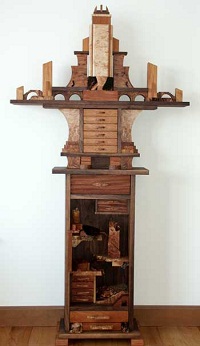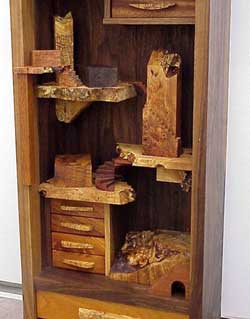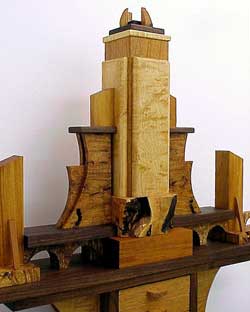Hall of the Mountain King (2001)

Dimensions: 32" W x 68" H x 10" D
Materials: walnut, maple, mahogany, maple burl
Finish: Tried n' True (TM) linseed oil
Recipient of the Association of Science Fiction and Fantasy Artists' Chesley Award for Best Three-Dimensional Work of 2001.

Imagine a fortress built from the materials mined on-site, a fortress that incorporates the mine itself into its structure. The fortress grows both above ground and below at the same time, with the visible and the hidden structures balanced lest the entire structure fail.
I chose a limited palette of walnut, mahogany, burl maple and figured maple to echo the limited range of materials that would likely be available for such a building. Walnut is for the bones, the original matrix of rock. The mahogany lies in layers, like sedimentary rock, bedding in cracks and gaps. Burl maple appears in chunks and lenses, cobbles of older material trapped in the sediments as they harden. Finally, figured maple enters like an igneous intrusion into previous layers.

Design Notes: "Hall of the Mountain King" began with the idea of two worlds, one above ground, one below, neither necessarily aware of the other's existence. The underground world would be a remnant of a vanished culture, maybe a barrow or a cavern that had been adapted for some human use, while the above-ground structure would be a city or that had risen up long after the cavern's culture had disappeared.
As I developed these ideas further, I grew more interested in the visible, above-ground structure growing out of the hidden, underground structure, and the way these two structures would have to grow together to be stable. Someone walking along on the "surface" of this world may never find out about the caverns beneath the fortress, but those caverns would ultimately determine whether or not the fortress would collapse.
The limited palette of woods I used in "Hall of the Mountain King" visually enhances the dependence of the fortress on the cavern. And, while I have incorporated stone or metal into some of my work, I chose not to do that here because it would would destroy the illusion I was trying to create that the different species of wood were mined and shaped stone. Real stone doesn't look much like wood.
And yes, it really is a jewelry box.
Thanks to...
Artists don't work in a vacuum. While creating "Hall of the Mountain King" I was strongly influenced by the incredibly beuatiful work of boxmaker Po Shun Leong and by my lifelong interest in geology and archaeology.
